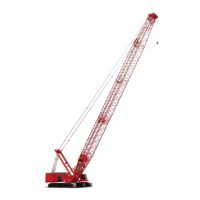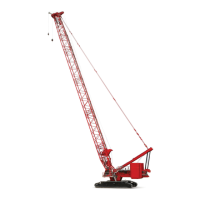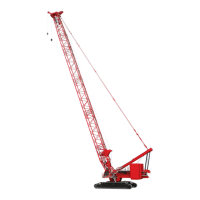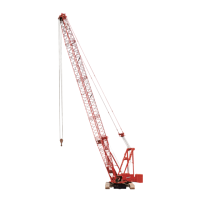HOISTS MLC300 SERVICE/MAINTENANCE MANUAL
5-50
Published 11-22-17, Control # 257-02
Rope That Has Been Idle a Month or More
Wire rope must be given a complete inspection if it has been
idle for a month or more. The inspection must be performed
by a qualified inspector looking for the damage identified
under both daily and periodic comprehensive inspection.
NOTE: Wire rope may be purchased through Manitowoc
Crane Care Lattice Team.
Distributing Wire Rope Wear
Wire rope wear at the “critical wear points” can be reduced
and the life of the wire rope extended by moving the rope at
regular intervals so that different sections of the rope are
subjected to the wear points. This practice can also help
correct spooling problems and rope vibration.
To move the wire rope, cut off a piece of the rope at the worn
end and refasten. The piece should be long enough to move
the wire rope at least one full drum wrap.
If the wire rope is too short to allow cutting off a piece,
reverse the rope end for end and refasten it.
SHEAVE, ROLLER, AND DRUM INSPECTION
Perform the following inspections weekly:
• Check the drum clutches and the brakes for proper
adjustment.
• Check all sheaves, rollers, and drums for the following
conditions:
- Unusual noises
- Freedom of movement—Must turn freely by hand.
Wire rope may need to be loosened to perform this
inspection.
- Wobble—Must turn true with very little side-to-side
or up-and-down play.
- Signs of rust (indicating that water may have
entered bearing).
- Grease leaks (indicating a faulty seal or water in
grease).
The above problems indicate bearing damage. If found,
the corresponding sheave, roller, or drum should be
disassembled for further inspection. New bearings
should be installed.
For sheaves not equipped with grease fittings, be sure to
pack the new bearings with grease at assembly.
• For steel sheaves, check the depth, width, and contour
of each sheave using a groove gauge (see Figure 5-30
).
Replace the sheaves that have oversized or undersized
grooves.
• Replace any grooved drums that allow one wrap of the
wire rope to contact the next wrap as the rope spools
onto the drum.
• Inspect the sheaves to verify they do not contact another
sheave or structural plate work. There should be uniform
clearance between sheaves in a cluster. Repair or
replace worn or damaged sheaves.
• Remachine or replace steel sheaves, drums, or rollers
that have been corrugated by the wire rope’s print (see
Figure 5-31
).
• Measure the nylon sheaves for excessive tread wear
(see Figure 5-33
). To check for uneven wear, measure
at three places.
Wear must not exceed the limit given. Replace worn or
damaged sheaves.
WARNING
Falling Load Hazard!
Replacement wire rope can break if it does not meet
Manitowoc Cranes specifications given in the following
publications supplied with your crane:
• Wire Rope Specifications Chart located in the
Capacity Chart Manual (for load lines)
• Boom or Jib Assembly drawings located in the
Operator Manual (for boom or luffing hoist)
• Mast Assembly drawing located in the Parts Manual
Item Description
1 Lay Length: distance in which one strand makes one
complete revolution around core
2Core
3Strand
4Wire
FIGURE 5-29

